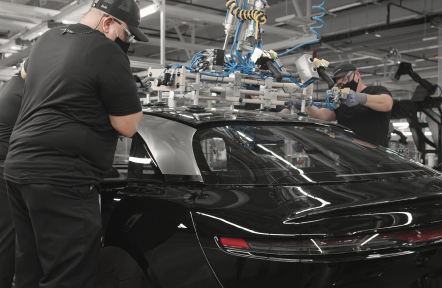Having just weathered the worst of the COVID-19 pandemic and dealing with the effects of the war in Ukraine, the United States and Japan have remained steadfast in building a stronger alliance — a partnership that has generated prosperity and provided stability across the Pacific and the rest of the world over the past 70 years.
Heralding a new phase of cooperation, U.S. President Joe Biden and Japanese Prime Minister Fumio Kishida announced last year the U.S.-Japan Competitiveness and Resilience Partnership (CoRe), an ambitious initiative that will accelerate cooperation in a wide range of fields, such as Japan’s Cancer Moonshot program, biotech, artificial intelligence, quantum information science, civil aerospace cooperation, cybersecurity, strategic supply chains and advanced manufacturing.

“It is my utmost priority to promote Japanese interests and safety in this area. Our two peoples are bound not just by our shared commitment to establishing and maintaining a global economic order, but also by our objective of achieving stability amidst rapidly changing geopolitics. Now more than ever, I look forward to stewarding this extraordinary story of cooperation between Japan and the United States,” said Ambassador and Consul-General of Japan in New York Mikio Mori.
Given the technical and geographical breadth of CoRe, the states of New Jersey, New York, Pennsylvania and Virginia have become ideal locations to base such collaborations.
“The East Coast is an obvious place to look. When you’re sitting on the amount of capital and financial resources that Japan has, New York and its surrounding regions as a market look really attractive. The challenge, of course, is that America is really large. Historically, Japanese companies have always looked to the East Coast, and this region has the largest and probably the oldest connections to Japan,” said Japan Society President and CEO Joshua Walker.
“Some of the biggest drivers of people are businesses because they are the means that bring about economic growth. And investment opportunities are ways through which people of different cultures get to know one another. That’s a real opportunity here on the East Coast,” he added.
In the field of space research and exploration, Masami Onoda, the director of the Japan Aerospace Exploration Agency’s office in Washington, D.C., welcomed the agreement between the Japanese government and NASA to build Lunar Gateway, which will eventually bring astronauts to the moon again.
“You can see that strong bipartisan support for space research activities from both houses of the U.S. Congress is continuing,” she said.
Amid very rapid technological innovations that have transformed the business landscape, Japanese imaging giant Ricoh has tapped into its technology and expertise to carve out a niche in the digital world and build an even stronger company.
“Our growth strategy is to make sure that we are finding adjacent services and offerings to our traditional print world. It’s all about data. How you take data and unstructured data, how you make it powerful and valuable, and support our customers on that journey. We are taking our growth strategy to the next level,” said RICOH North America CEO Carsten Bruhn.
“For example, we are investing in some new ideas. We just got FDA approval for 3D printing for the healthcare sector. So, we are creating an ecosystem where we are working in with the healthcare industry to make 3D prints of say, an implant. But it’s much more than 3D prints of a spine. It allows a surgeon to look at patients more quickly, perform surgeries sooner, use less anesthetics, get them home more quickly and recover faster,” Bruhn also said.
Meanwhile, following the demise of traditional manufacturing in the 1980s, the eastern states have seen growth in the life sciences sector.
“Upstate New York has a very impressive nanotechnology complex where the Japanese arm of IBM operates and many young Japanese technology workers are based. Pennsylvania, on the other hand, has the second-largest concentration of Japanese within the consulate’s jurisdiction. We also have been traditionally strong in the pharmaceutical, biochemical and automotive industries,” Mori said.
In Troy, New York, Rensselaer Polytechnic Institute is again living up to its reputation as a pioneer in technological innovation. Established in 1824, at the height of the Industrial Revolution in the United States, RPI was the first technological research university in the country and the English-speaking world.
“We recently created a center called the Future of Computing Institute to combine activities, such as artificial intelligence, data analysis and computation, to amplify their impact. In addition, we are focused on issues surrounding energy in the built environment, and we have numerous research activities in this area,” said RPI President Dr. Martin Schmidt.
“We are also building a growing presence in New York City as a platform in which to experiment with ideas coming from our faculty, particularly in the School of Architecture, in the areas of sustainability, climate change, and decarbonization. We are also leveraging our strong computer science activities on the critical problems facing rapidly expanding urban centers worldwide,” Schmidt added.
“We recently launched a partnership with the Icahn School of Medicine at Mount Sinai in New York City that brings the power of engineering to precision medicine. We see many opportunities in research through this partnership which is unique in New York City.

Additionally, we are deeply engaged with the region around the university, in Troy and Upstate, NY, to use the Institute’s capacity in research, as well as our robust computational ecosystem, to create pathways to innovation for industry to reinvigorate the local economy and create jobs through the manufacture of semiconductors and nanotechnology that leverage the government’s game-changing investment in chips,” he also said.
If CoRe is to succeed in meeting its ambitious agenda, it will be mostly through the private sector and public-private partnerships. At the heart of these efforts is the Japan External Trade Organization, which launched J-Bridge, a platform that connects Japanese and international companies looking for business opportunities overseas.
“J-Bridge projects are developed all over the world. But in the case of the United States, in 2021, we promoted the field of carbon neutrality. This year, in 2022, we added the digital transformation field. Now, we are gathering information on which American startups would be interested in collaborating with Japanese companies in their digital transformation efforts,” said JETRO New York President Kenichi Kawamoto.









